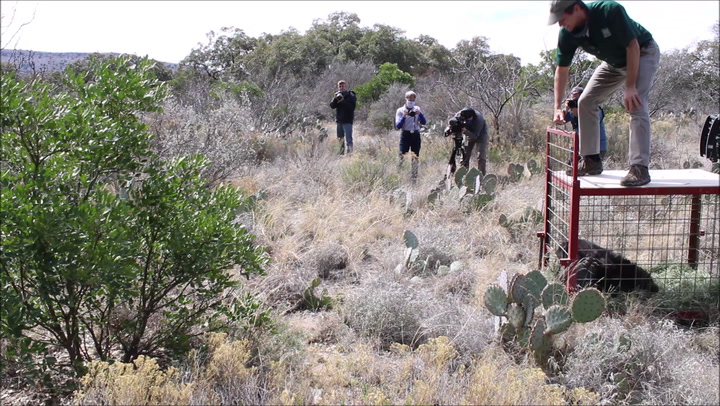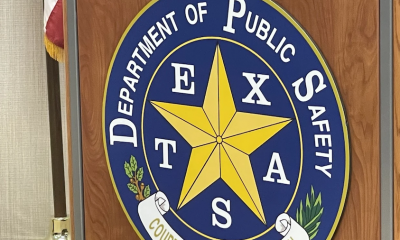Texas
First rehabbed Texas black bears released at Devils River State Natural Area

TX – Deep in the desert shrublands of the Devils River State Natural Area, Texas history was made.
A landscape so harsh, so beautiful was the setting Thursday for the release of two black bears, the first from Texas to go through the rehabilitation process.
Momma Tex, a 4 or 5-year-old black bear, was the first to freedom. After arriving in rehab completely emaciated and encumbered with parasites, she lumbered from her cage healthy and elegant, as if enjoying the photo opportunity.
Miss Texas, about a year old, was camera shy. She darted from her cage as soon as it opened. Miss Texas arrived at Cottonwood Wildlife Rehabilitation Center in Española, N.M. as a 10-month-old orphan cub that weighed less than 20 pounds. Her mother was killed by a Del Rio resident after she was likely attracted to a feral cat feeding station. Miss Texas emerged from her cage plump and energetic.
Both entered their new home miles apart among the staggering canyons in the rocky-yet-semi-lush paradise of the Devils River SNA.Overseeing the scene was Kathleen Ramsay, a veterinarian who has rehabilitated more than 600 bears in more than 40 years of veterinary practice and an intriguing character whose knowledge, experience and charisma could easily command a room. She and her crew from Cottonwood (her son, Ty Horak, his wife Nirankar, and James Robinson) worked in collaboration with Texas Parks and Wildlife Department to turn these bears into success stories.
Ramsay overcame the challenges of rearing these two bears that are unlike any she’s come across in her career. The Mexican subspecies that are found in West Texas are genetically distinct and behave far differently than the ones from New Mexico she is accustomed to; they don’t hibernate the same way her usual bears do. Ramsay had to find native food and teach these bears to fear humans in order to give them the best chance of survival.
She also had to put up with Miss Texas, who has been described as a “hoot,” a “riot” and a “wild child.”
“I’m going to miss this bear even more, because she is just nothing like any other bear,” Ramsay said.
Miss Texas is an alpha that loved to wrestle with a male bear twice her size and cause miscellaneous mischief.
“She’s been a trip from the very beginning. A total trip,” Ramsay said. “She is just perpetual motion. I have never caught her sitting still.”
Ramsay overcame the obstacles while caring for several other bears from New Mexico and an Arizona bear named Miss Nah-ghizi (Navajo word for squash), and numerous other animals. She is a renowned raptor rehabilitator and will care for any animal under any circumstance, no matter if it be elk, lizard, eagle or bear.
“It’s an honor,” Ramsay said of being the first to rehab Texas bears. “I hope I did a really good job.”
The pair of bears will have plenty of room to roam on the 37,000-acre Devils River SNA, where they’ll be able to avoid human interaction. Having a permanent water source and the riparian areas that accompany it should help. And though the terrain is no country for old men, these bears are tough enough to handle it.
“Bears are habitat generalists,” said Jonah Evans, TPWD’s state mammalogist.
“They’re able to survive in a very wide variety of habitats. They eat all kinds of foods, they are opportunistic. And historically they occurred everywhere in the state.”
A discovery was made shortly before the trip to Texas. Momma Tex had her name changed from Mr. Tex after it was revealed she is not a boar, as previously thought. That bodes well for what these bears can do for the local population in the future.
“It’s much better. Because another male would mean potential problems for females,” said Evans, noting how males can sometimes kill the females.
Two females added to the breeding population is substantial, too, although bear population growth is a slow process. The bears in West Texas usually breed every other year and often have one or two cubs, compared to the four to six cubs East Coast bears can have.
If Texas bear populations continue to grow gradually, instances of human conflict and interaction will likely rise.
“My predecessor worked for the department for 35 years and he put his hands on two bears his entire career,” TPWD wildlife biologist Ryan Schmidt said while driving to release the second bear of the day.
“We’re seeing a huge uptick. Because of the drought in Mexico, the mountains are in such poor shape out there and that’s what’s driving these bears northward, trying to find better habitat.”
While that uptick is happening in West Texas, black bear activity has increased on a much smaller scale along the Red River due to flourishing populations in southeast Oklahoma and southwest Arkansas. Louisiana, too, is working to restore its own subspecies of black bear.
The bears in Northeast Texas are limited to transient males, so far. Here in the borderlands of West Texas, though, black bears appear to have gained a foothold.
“We’ve actually documented cubs being born here, where we have little ones that couldn’t have made the trek 50-75 miles inland,” said Schmidt.
“They had to have been born in Texas.”










